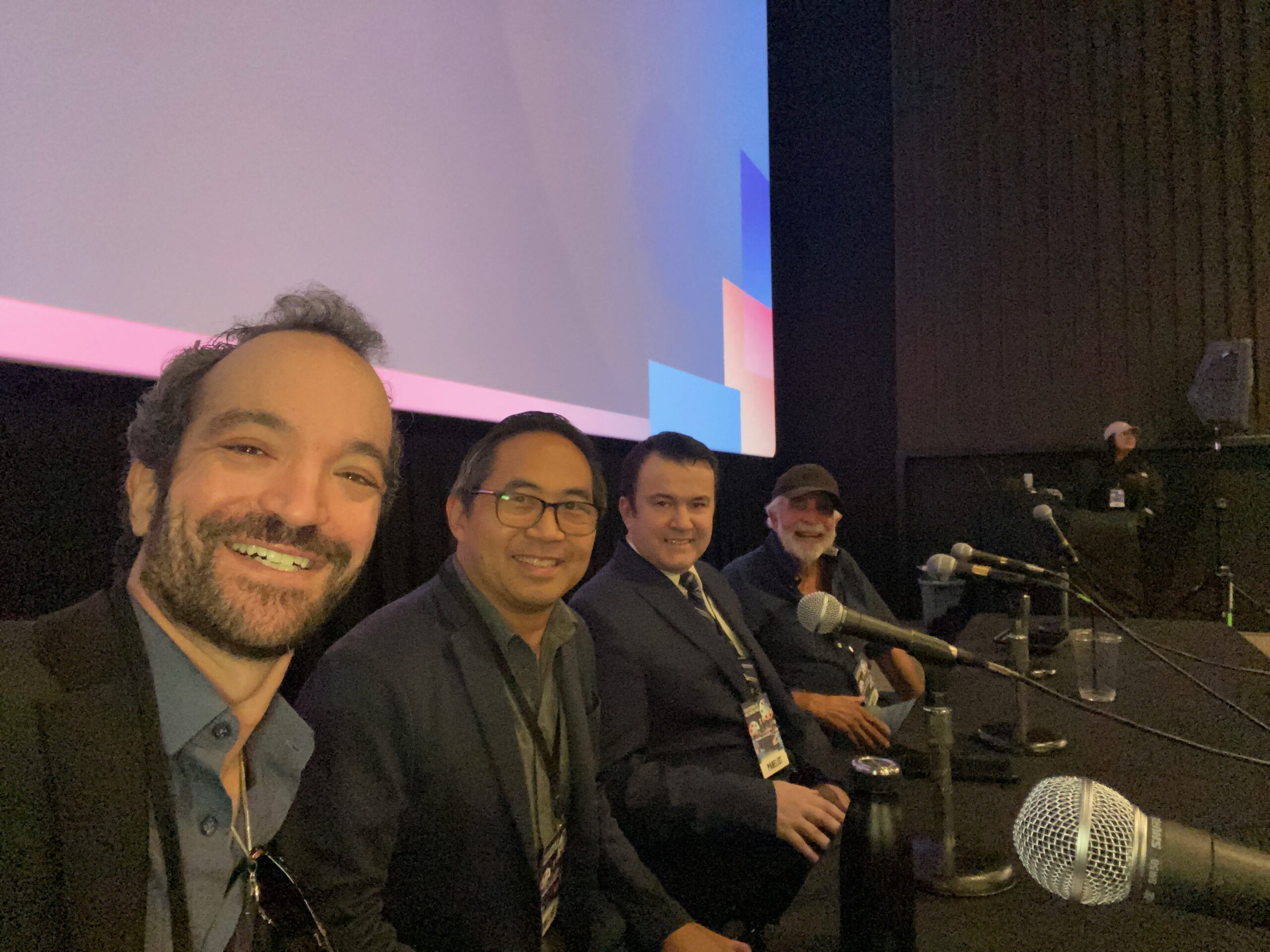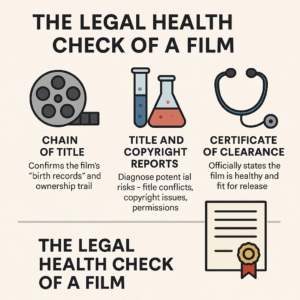Chain of Title, Title Reports, Copyright Reports, and Certificates of Clearance

Jason Daks, Clifford Lo, Ernest Goodman, and Bruce Nahin at the panel of the Film Festival at Hollywood Park.
Introduction: Law Is the Skeleton Beneath the Art
During the Hollywood Park Film Festival in 2025, where I served as a panelist on the “Deal or No Deal” legal discussion, several filmmakers and producers approached me with detailed questions about title searches, copyright searches, and other intellectual property clearance issues. Many were surprised to learn that before a film can be distributed or insured, it must pass these legal checkpoints — verifying that its title is unique, its creative materials are properly licensed, and its ownership chain is complete. Our discussion highlighted how essential these steps are not just for major studio productions but for independent filmmakers as well, since proper IP clearance can determine whether a project successfully reaches audiences or becomes trapped in legal limbo.
Every great film begins with a spark of imagination — but every distributable film begins with documentation.
A film may be beautiful, heartfelt, and visionary, but without a clear record of ownership, it simply cannot move through the commercial pipeline.
Streaming platforms, distributors, and insurers don’t just look at what’s on screen — they look behind it, demanding proof that every word, every note, and every frame has been legally acquired and cleared.
In entertainment law, we often say that creativity brings a film to life, but law keeps it alive.
This legal architecture is built through four essential components that form the foundation of a film’s marketability:
– Chain of Title – The record of who owns the rights.
– Title Report – Verification that your film’s name doesn’t conflict with others.
– Copyright Report – Assurance that all content is original or properly licensed.
– Certificate of Clearance – The legal “doctor’s report” certifying your film is healthy for release.
Our discussion centered on the due diligence behind every production deal — and how clearance determines whether a film ever reaches its audience.
This article expands on that discussion, explaining in depth what these four pillars mean and why they are indispensable for producers, lawyers, and creatives alike.

🎥 1. Chain of Title — The Legal DNA of a Film
Definition
The Chain of Title (CoT) is the backbone of film ownership.
It’s a continuous, chronological record of all agreements that transfer, assign, or confirm the rights in a creative property — from the original author to the production company, and ultimately, to the distributor.
If even one link in that chain is missing, the entire film can be rendered legally unstable — or worse, unreleasable.
Purpose
The Chain of Title serves several vital legal functions:
1. Proof of Ownership — Demonstrates who actually owns the film’s story, script, and characters.
2. Eligibility for Distribution — Distributors will not touch a film without a clear chain.
3. Insurance Requirement — E&O insurers demand it before issuing coverage.
4. Investor Confidence — Financiers require proof of ownership before releasing funds.
Essentially, it tells the legal story of the film itself.
Documents That Form the Chain
A complete Chain of Title includes a broad array of documents:
– Option Agreement – Allows a producer to develop an existing work for a set period.
– Assignment Agreement – Permanently transfers rights from creator to producer.
– Work-for-Hire Agreements – Ensures employees’ or contractors’ contributions are owned by the producer.
– Collaboration or Joint Author Agreements – Clarifies ownership among co-writers or creators.
– Talent Releases – Grants the right to use actors’ performances, likenesses, and voices.
– Music Licenses – Covers synchronization and master-use rights.
– Location and Artwork Releases – Prevents claims from property owners or artists.
– Corporate Assignments – Transfers rights into the production entity (e.g., from the writer personally to their LLC).
Each of these forms a “link” in the chain. Missing or unsigned links weaken the legal structure.
Example
Imagine a film called The Silent Ocean, adapted from a short story by Jane Park.
Jane signs an option agreement with producer Alex Rivers, who later exercises it and assigns all rights to Silent Ocean Films LLC.
A screenwriter adapts the work under a work-for-hire agreement, and the composer licenses an original score.
Each transfer — from Jane to Alex, from Alex to the company, from collaborators to the producer — forms part of the chain.
If any party failed to sign, the film would face uncertainty in ownership.
Distributors, always risk-averse, would likely walk away.
That is why an attorney’s review of every document in the chain is indispensable.
Why It Matters
Without a verified Chain of Title:
– The producer cannot prove ownership.
– The insurer won’t underwrite coverage.
– The distributor cannot release the film.
With a strong chain, however, a film is legally alive — ready to enter the marketplace with its identity verified.
🪪 2. Title Report — Clearing the Name
Definition
The Title Report ensures that a film’s name is legally safe and non-infringing.
It’s a comprehensive search that blends trademark law and entertainment law, verifying that no other film, series, or franchise has a confusingly similar title.
It’s one of the first steps toward building a film’s public identity — its legal nameplate.
Who Performs It
At the Law Offices of Ernest Goodman, we prepare Title Reports and related intellectual property clearance documents in-house as part of our entertainment law practice.
Our office conducts comprehensive title searches, combining trademark law and entertainment clearance analysis to confirm that a film’s title is legally safe, non-infringing, and market-ready.
We access and review multiple databases — including the U.S. Patent and Trademark Office (USPTO), WIPO, and major entertainment title registries such as the Motion Picture Association (MPA) and IMDb Pro — to identify potential conflicts across film, television, streaming, and literary media.
By preparing these reports directly for producers, we ensure that any issues are identified and resolved early in development, allowing the film’s public identity — its legal nameplate — to be established with confidence and precision.
Example
Suppose your film is titled The Crown of Justice.
The report reveals potential conflicts with The Crown (Netflix) and Justice League.
Even if unrelated, the similarity could cause confusion or legal challenge.
Your attorney might recommend adjusting the title — say, Crown of Shadows — to eliminate that risk.
Legal Foundation
While titles are not protected by copyright, they are covered under trademark and unfair competition law if they acquire distinctiveness.
A Title Report thus functions as a preemptive defense against potential infringement.
Practical Value
– Required by distributors, streamers, and E&O insurers.
– Prevents rebranding crises late in post-production.
– Saves thousands in legal fees by resolving conflicts early.
In the same way that a film’s score must be original, its name must be legally unique.
🧾 3. Copyright Report — Verifying Originality and Legal Safety
Definition
The Copyright Report is the forensic analysis of a film’s creative components.
It verifies that everything on screen — text, sound, image, or footage — is either owned, licensed, or in the public domain.
This is the most labor-intensive step, and often the most crucial.
Scope
The report typically covers:
– Script and story: Confirms ownership and originality.
– Music: Verifies licenses for composition and master recordings.
– Images, clips, and footage: Checks that each element is cleared.
– Logos or brands: Evaluates whether fair use applies.
– Books, posters, or artworks: Ensures reproduction rights are granted.
– Dialogue excerpts or quotations: Confirms permissions or fair use.
Example
A documentary includes a ten-second clip of a historic news broadcast.
The attorney must confirm both the broadcaster’s permission and the music rights if a recognizable theme plays in the background.
Even minor details — like showing a corporate logo on a passing truck — are analyzed for potential claims.
Why It Matters
Copyright Reports are critical for:
– Avoiding infringement lawsuits.
– Satisfying E&O insurers who require evidence of due diligence.
– Providing distributors with assurance that every component is cleared.
If an infringement claim surfaces later, the producer can show the report as proof of good faith and diligence — often enough to satisfy insurers and mitigate liability.
🪶 4. Certificate of Clearance — The Final Legal Seal
Definition
Once all underlying ownership documents, title searches, and copyright clearances have been thoroughly reviewed, the attorney issues what is known as a Certificate of Clearance — sometimes called a Legal Opinion Letter or Clearance Certificate.
This document serves as the official legal summary and final confirmation that the film has been fully examined from an intellectual property standpoint and is approved for release and distribution.
At its core, the Certificate of Clearance is the attorney’s professional legal opinion — a formal assurance to insurers, distributors, investors, and streaming platforms that the production has met all clearance standards required for commercial exploitation.
It confirms that the producer’s Chain of Title is complete, the Title Report shows no conflicts, and the Copyright Report verifies that all creative materials are either owned, licensed, or lawfully used.
In practice, the certificate functions like a legal passport for the film, authorizing it to move through the global distribution system.
Without it, even a fully produced movie may be considered legally unverified and may be rejected by E&O insurance carriers, streaming platforms, or international distributors.
Contents
A typical Certificate includes:
– The film title and production company.
– The scope of review (which documents were examined).
– A summary statement confirming no material legal issues.
– A disclaimer noting reliance on available data.
– The signature of the issuing attorney or firm.
Purpose
This certificate is the final key that unlocks distribution, insurance, and release.
It signals to investors, E&O carriers, and distributors that the project has passed full legal examination and is safe to exhibit commercially.
🩺 The Doctor’s Report Analogy
Legal clearance is remarkably similar to a medical evaluation.
Just as a patient must undergo diagnostic tests before being declared healthy, a film must undergo its own legal check-up.
| Medical Equivalent | Legal Equivalent | Purpose |
|---|---|---|
| Medical History | Chain of Title | Confirms a film’s legal “birth record” and ownership lineage. |
| Lab Tests | Title Report and Copyright Report | Detects potential risks: conflicts, infringements, or missing permissions. |
| Doctor’s Summary Letter | Certificate of Clearance | The attorney’s professional opinion that the film is healthy for public release. |
✍️ Written by Ernest Goodman, Entertainment & IP Lawyer.
⚠️ Disclaimer by Ernest Goodman, Esq.
This article is intended for informational purposes only and does not constitute legal advice. Reading or relying on this content does not establish an attorney-client relationship. Because laws differ by jurisdiction and continue to evolve readers are encouraged to consult a qualified attorney licensed in the relevant jurisdiction for advice tailored to specific circumstances.
.





